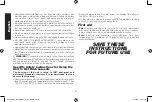
English
8
Connectors and Cables (Fig. 3)
I. Double Barrel Charger
Connector (connects to
Clamps or Battery Terminal
Rings)
J. AC Plug
K. Battery Terminal Rings
L. Battery Clamps
I
J
K
L
Preparing to Charge
1. Be sure the area around battery is well ventilated while the battery
is being charged.
2. Remove the battery completely from a boat/airplane or any confined
area before charging.
3. If it is necessary to remove battery from a vehicle to charge or to
clean terminals, always remove the grounded terminal from the
battery first. Make sure all accessories in the vehicle are turned
off, so as not to cause an electrical arc.
4. Clean the battery terminals, taking care to avoid getting corrosive
material in your eyes.
5. Add distilled water in each cell until battery acid reaches the
level specified by the battery manufacturer. This helps purge
excessive gas from cells. Do not overfill. For a battery without cell
caps (maintenance free), carefully follow manufacturer’s charging
instructions.
6. Study all battery manufacturer’s specific precautions, such
as removing or not removing cell caps while charging, and
recommended rates of charge.
7. Determine the voltage of the battery to be charged by referring to
the vehicle manual. This unit is for charging a 12 volt battery only.
CHARGER LOCATION
• Locate the charger as far away from the battery as cables permit.
• Never place the charger directly above the battery being charged;
gases from the battery will corrode and damage the charger.
• Never allow battery acid to drip on the charger when reading gravity
or filling the battery.
• Never operate the charger in a closed-in area or restrict ventilation
in any way.
• A marine (boat) battery must be removed and charged on shore.
To charge it on board requires equipment specifically designed for
marine use. This unit is NOT designed for such use.
DXAEWPC4_ManualENSP_Type2_010920.indd 8
1/9/2020 2:20:28 PM










































